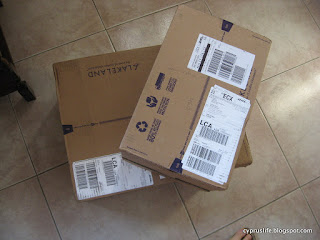Earlier this year, when apricots were abundantly in season, my friend Sheila and I talked about how good it would be if we could make our own dried fruit, to preserve apricots - among other things - for the winter months. They would be considerably less expensive than dried apricots in the shops, and free from nasty preservatives.
We have guaranteed sunshine for several months, so after some discussion Sheila rigged up a system with trays, and mosquito netting, and set some apricots to dry on their roof. These took several days, and had to be taken in overnight (when the humidity is extremely high) - but the results were very good indeed. However, the hassle was such that I never actually tried it myself...
Sheila mentioned that her mother had a home dehydrator, but when I searched online, out of curiosity, most of them were very expensive - a couple of hundred pounds or more - and consumed extensive electricity as well, something which is very highly priced here in Cyprus. I put it out of my mind.
Fast forward a few months. Richard and I were in Sussex, and visited Lakeland. We saw a £50 dehydrator, with five trays. We were very tempted indeed - I had some birthday money, and we thought we had space in our luggage. But we managed to resist. But we kept talking about it. And then after we returned to Cyprus, I learned that if I had a dehydrator, I could make coconut flour out of what remains when I made my own coconut milk...
When I looked on the Lakeland website for something else (a coffee maker for Richard's birthday)... I discovered that their postage charge to Cyprus was only £7.50, no matter how large the parcel. And it came via courier. Grapes were in season by then, as well as plums, and I kept thinking about making my own dried fruit... so I made the order. A week later, a courier arrived with the parcels:
There weren't many instructions, but I reckoned I could experiment with different types of fruit, and see how long everything took. I had various random fruit, so a few days later I tried some apple pieces, and some banana slices:
I realised that the coconut meal would slip through the gaps in the trays, so improvised by cutting one of my small muslin squares to an approximate fit:
Then I switched it on!
It didn't get as hot as I had expected - so although the instructions told me to use oven gloves, I found that unnecessary when pausing to check how things were doing, or to move the trays around. Since it's a simple and relatively inexpensive gadget, it has just one heat setting, and the air isn't all that even so it's a good idea to move things around, and to remove fruit that's finished on any tray.
By the end of the first day, which included some necessary (and very enjoyable) testing, I had made the coconut flour, and removed the dried pineapple, bananas and apples. Friends were coming to dinner, so I put them out with our dessert, to try:
Richard liked the bananas best. They were squidgy rather than banana chips, and he said they reminded him of some delicious banana pieces he'd eaten when camping as a teenager. He asked if I could try cutting them lengthways next time. One of our visiting friends liked the apple best, the other liked the pineapple best. And I couldn't decide...
A day or two later, after we'd eaten most of the fruit salad, Sheila and I were talking about 'fruit leather', something made from fruit puree in a dehydrator. I cut some baking paper to fit, pureed the now rather squashy fruit salad, and set it to dry:
The fruit leather turned out very well after just a few hours. I had to leave it to cool, then cut it into wedges. They peeled nicely from the backing paper, and were rather tasty.
The electricity usage is about 1 unit for four hours, which isn't bad at all, and the taste is so vastly superior to anything we can buy ready-dried that it's worth it for that alone; not needing any sugar or other preservatives is a huge bonus.









1 comment:
This is above and beyond the call of duty. :)
Post a Comment